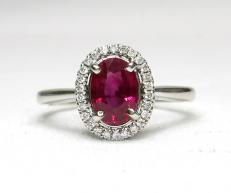The ruby is one of the world’s most valuable and highly sought-after gemstones in the world. Derived from the Latin word ‘ruber’ meaning ‘red’, the ruby is a gemstone for those born in July, and is the most valuable variety of the corundum mineral species – which also includes the sapphire.
Rubies are often associated with wealth, prosperity, vitality and wisdom. So if you’re interested about the history, stones and styles of jewellery that best celebrate this precious red gemstone, read on for our complete guide to rubies.
What is a ruby?
Similar to other gemstones, rubies are graded based on colour, cut, clarity and carat. Rubies have a Mohs hardness of 9, and its red colour is formed by the trace element of chromium.
A ruby’s colour is its most important feature. Rubies are available in a wide range of hues, from blurish red to an orange-red. Burmese rubies are the brightest and most valuable ruby colours – reflecting a rich, full red colour that is often referred to as a ‘pigeon blood’ red. As the colour of a ruby is similar to the colour of blood, rubies are often associated with life and vitality.
Large rubies with strong clarity and colour are extremely rare, and therefore more valuable. Rubies that have inconsistencies or disruptions in colour are less valuable than their clear, richly-coloured counterparts.
History of rubies
Rubies have a rich historical significance to multiple countries and cultures across the world. And with this significance comes a host of myths and legends – originating when the gemstone was referenced four times in the Bible, and noted as the most precious of the 12 stones created by God.
In ancient India, the ruby was the “king of precious stones”, and was prized for its hardness, rarity, beauty and perceived mystical powers. In Burma (now called Myanmar), warriors would hold rubies to make them invincible in battle – and in some cases, rubies would be inserted into their flesh to make the gemstone ‘part’ of their bodies. Myanmar is one of the oldest recorded sources of fine rubies; as for more than five centuries, Myanmar’s Mogok area has produced some of the world’s most exquisite rubies.
Vietnam is another important region for rubies. The Luc Yen region in northern Vietnam produces an array of red to purplish rubies annually, and the Quy Chau district further south has also fielded precious rubies.
With the birth of the western world, rubies became one of the most sought-after gemstones of the upper classes and European royalty. Medieval Europeans also maintained that rubies bestowed health, wisdom and wealth – and similar ancient civilisations believed that rubies could relieve inflammation and heal wounds from battle.
Today, the Smithsonian National Museum of Natural History is home to some of the world’s most famous rubies – notably, the Carmen Lucia Ruby that consists of 53 carats and a rich, ruby red colour. Another notable ruby display in this museum is Dorothy’s Ruby Slippers from the 1939 film ‘The Wizard of Oz’. These iconic shoes are kept in fine condition in a temperature-controlled, alarm display case in the Gateway to American Culture wing of the museum, took over 200 hours to restore, and have as many as 2,400 ruby sequins on each shoe.
What are the different types of rubies?
As mentioned above, Burmese rubies are one of the highest quality rubies; renowned for their deep red colour. Other ruby types include African rubies, Thai rubies, Tanzania rubies, Madagascar rubies and Afghanistan rubies. Each of these types can be characterised by their unique colouring and premise of blemishes.
How did rubies become the birthstones for July?
Scholars can trace a gemstone-defined calendar back to the Breastplate of Aaron as described in the Bible’s book of Exodus. The Breastplate was adorned with twelve gemstones that represented the tribes of Israel at the time – and based on this model, the modern birthstone list was created in 1912. It has since been defined by the National Association of Jewellers from the United States, and forms the justification of the ruby’s association with the month of July.
In addition to representing the July birthstone, rubies are traditionally given for 15th and 40th wedding anniversaries.
What jewellery pieces does this July birthstones go best with?
Rings, pendants, earrings and bracelets are popular options for ruby gemstone settings, as each option provides a vibrant pop of colour. They are particularly striking when set in diamond engagement rings, especially in three stone settings.
When it comes to metal selection, pairing rubies with white gold or platinum can evoke an air of style and sophistication. If you opt for a yellow gold, this can create a warm and unique piece, or if it’s a yellow gold you’d prefer, this can create a romantic statement.
No matter which jewellery style you choose, rubies are guaranteed to stand out in even the simplest stud or pendant because of its intense, vibrant colour.
How to keep your ruby jewellery in good condition
Caring for your ruby jewellery can be done with warm soapy water and a soft-bristled brush. Soaking your jewellery in this warm soapy water for a few hours will loosen dirt and oils. Next, use your soft brush (this can be a toothbrush) to clean the crevices of your jewellery piece, and then wipe the piece dry with a cloth. When cleaning, don’t forget to attend to the inner side of the piece as this is what comes in contact with your skin the most.
Whether it’s a ruby engagement ring, pendant or bracelet, look no further than the expert team at Perth’s Allgem Jewellers. Conveniently located in Hay Street Mall in the CBD, Allgem’s wide range of gemstone jewellery pieces, including a range of ruby pieces, is sure to suit all design preferences. Contact our professional master jewellers or visit our showroom to take a look at our wide range of luxurious gemstone jewellery.



 Sign in
Sign in Cart
Cart